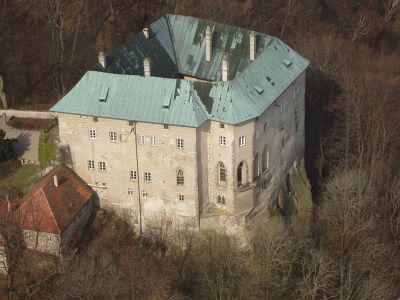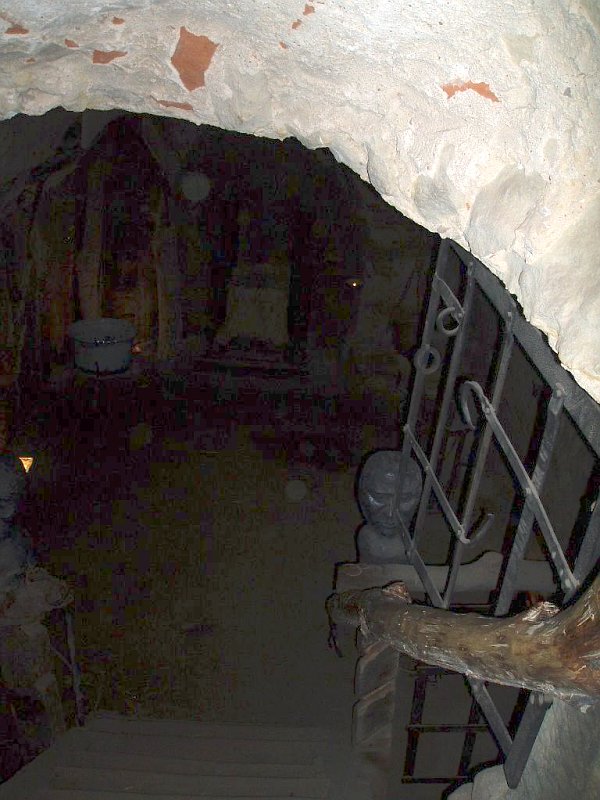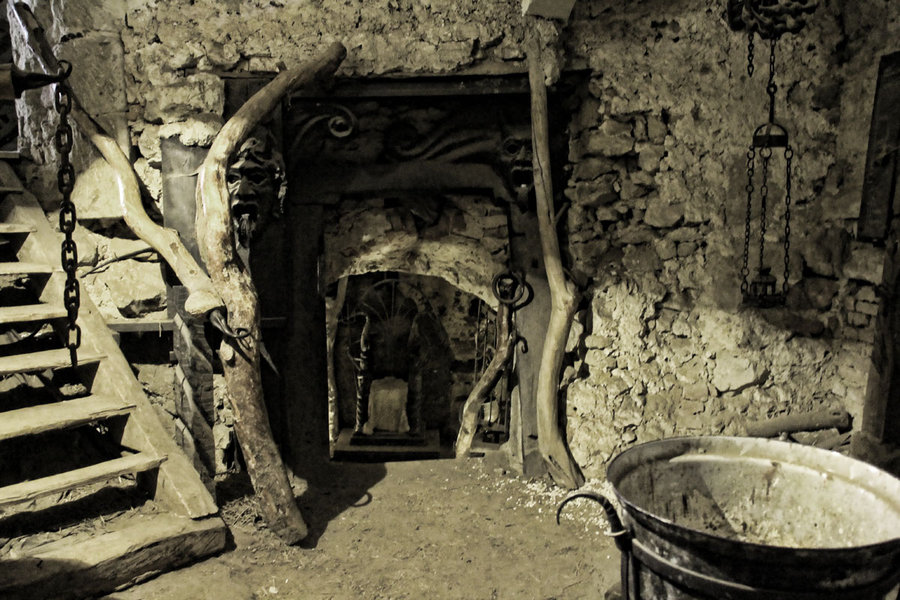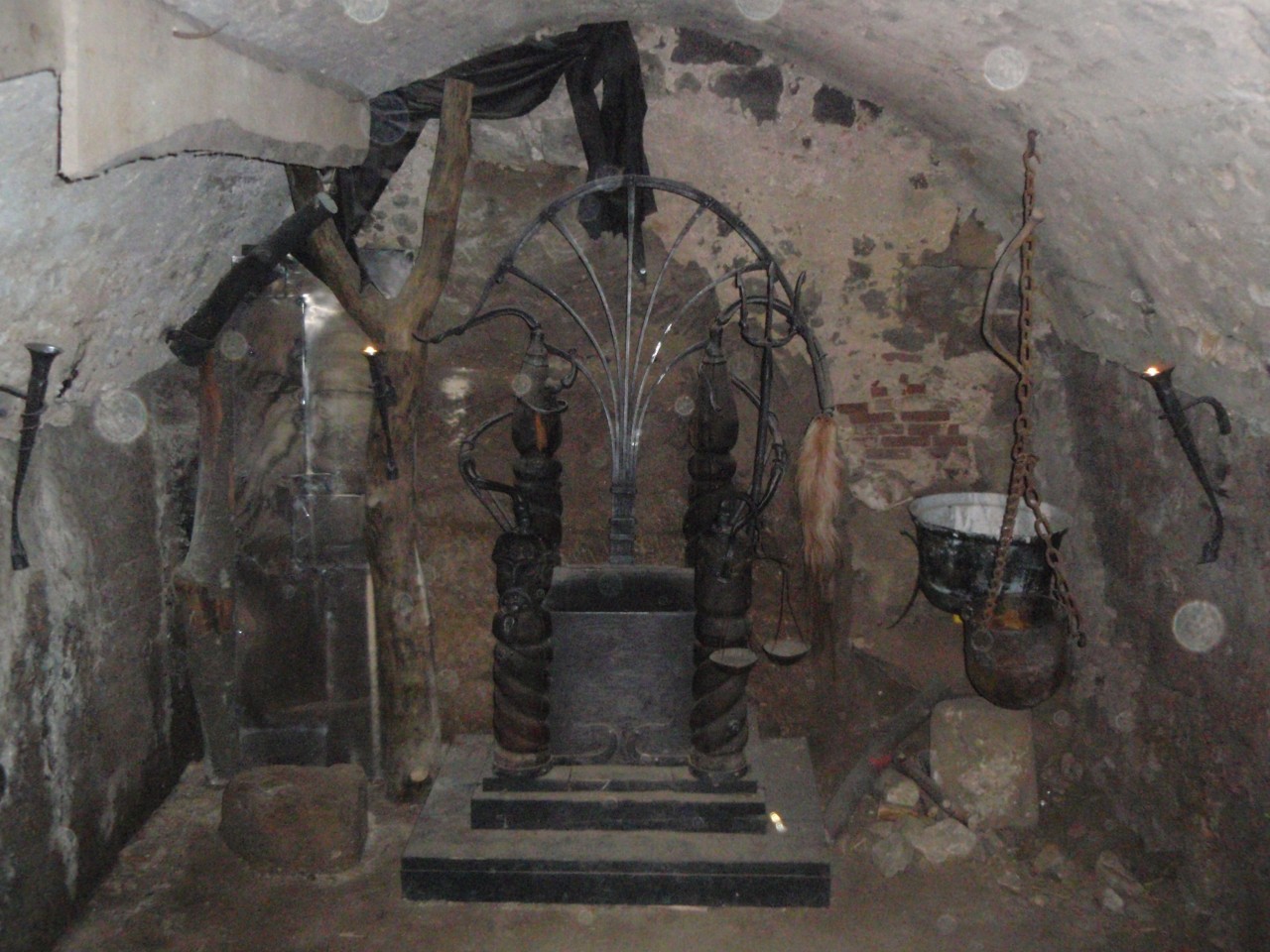
|
|||
Houska Castle - An Evil Gateway to Hell - Unexplained Mysteries
Source : http://www.mcgeesghosttours.com/castle-houska/
Looming In the mountains north of Prague you’ll find Houska Castle, an 800 year old structure with an evil reputation.Houska Castle, known locally as the Gates to Hell in the Czech Republic it is thought to be one of the most haunted locations in the world. Demonic entities are said to be seen in the chapel, along with strange moaning, screams and voices. Legends say the castle was constructed to close off a bottomless chasm, a gateway to hell that is now covered by the castle’s chapel. Built over the remains of an older timber fortress, there are several oddities about its construction that have added to this legend. The castle is far from any strategic locations and the outside works are lacking many of the traditional fortifications expected in a 13th century castle. The fortifications that were in place seem to have been better designed to keep enemies within the castle than to keep them out. Stories tell of half-man, half-beasts who crawled from the pit and strange flying creatures who burst out of the darkness. Convicted criminals were offered a pardon by the king if they would agree to be lowered into the hell gate and report back what they saw. The first to descend was said to have screamed in terror and when he was pulled up his hair was white. The experience drove him mad and none know what he saw in the depths.  The castle’s dark reputation followed it down through the ages. During the 30 Years War it was said that a renegade Swedish commander and his force of brigands took the castle as a headquarters. Emperor Ferdinand III reportedly called it, “the cursed castle”. Tales also tell of kings or monks who have hidden treasure within its walls. Evil still plagued the castle into the modern era and during the Second World War the castle was taken by the invading German army. There are rumors of strange interdimensional experiments by the SS being conducted in its dungeons. This ancient stone structure has for centuries held a certain notoriety in the region of northern Bohemia in the Czech Republic. Why have local people always avoided the castle and surrounding area, fearing that some evil lurks there? Why is it that so many dead birds are so often found in the castle's inner courtyard? Why was this castle built on a site that was historically covered with impenetrable woods, not even suitable for hunting, with no nearby borders or trade routes to defend? Why did the Swedish mercenary leader and black magician Oronto decide to make this castle his home and laboratory in 1639, and what was he doing there that terrified the local peasants so much that they assassinated him? Why was Castle Houska occupied by the occult-influenced Nazi SS during the Second World War when its location was of absolutely no strategic value? Indeed, Castle Houska has long been a place which inspires a sense of fear and mystery and which raises many questions. Definite answers, however, are few and mostly conjectural. The legends surrounding the site of Castle Houska are older than the castle itself. There is archeological evidence of Celtic inhabitation in this area dating back into antiquity and Slavic tribes migrated here in the 6th Century. The first known structure existing on this site was a small wooden fort that stood here back in the 9th Century, mentioned by Václav Hájek in his extensive Czech Chronicle published in 1541. In the same chronicle Hajek also recounts a legend, the story of a strange crack in the top of the limestone cliff, a hole in the ground unimaginably deep, and reputed to be the source of strange visitations. Local residents began calling it a hole to Hell, and the villagers avoided passing anywhere near it after dark. They believed that strange creatures, half animal and half human, issued forth from the portal to kill livestock and wreak other havoc in the night. They also believed that any person who passed near the site was himself in danger of being changed into one of the creatures of the pit. They attempted to fill the hole with stones but with no success as it swallowed everything they dropped down it with no visible effect.
Another very peculiar fact about Castle Houska is that when the square stone structure was originally constructed in the 13th Century, most of its defenses were not facing towards the outside but were built facing inward towards the inner courtyard of the structure. So supposedly it looked not as if the castle had been built to keep an enemy outside, but rather to keep something inside from getting out. There were no stairs leading from the upper floors of the castle down into the courtyard. This is not evident today because after the 30 Years War in the middle 1600s the castle's tower, moat and other defenses were dismantled as part of a decree issued by Emperor Ferdinand III to make private castles more accessible and less defensable. Houska's earthen ramparts were also taken down at that time. Finally, at the beginning of the 18th Century the castle was remodeled into a Rennaisance chateau and then during the Communist period it fell into general disrepair. Today it is a relatively unimposing but ancient-looking structure which is in the process of repair and renovation by its current owners, Jaromír Simonek and Blanka Horova.  As the first gothic-style castle known to exist here, Hrad Houska was constructed between 1270-1280 during the reign of King Otakar II. When the castle was built, the crack in the limestone was covered with thick stone plates and the castle's chapel was constructed on top of it in order to seal the hole to Hell. The chapel was then dedicated to the Archangel Michael, the leader of God's armies in the fight against the hordes of Hell. Faded frescoes on the chapel's walls, some of the oldest found in Europe which date back to the early 1400s, depict Michael in two scenes. In one he is fighting a dragon, a symbol of evil, and in the other scene he holds a sword in one hand and a set of scales in the other and is weighing souls at the Last Judgement. Depicted also are scenes of the Cruxifiction and St. Christopher, but what is strange about the chapel frescoes is that on one of the walls can be seen a figure unlike any other found in other paintings of the time. Here we see a creature with the upper body of a woman and the lower body of a horse, holding a bow in her right hand and with her left aiming an arrow at a human figure. Not only is it exceedingly unusual to find a representation of a centaur, a creature of pagan mythology, adorning the walls of a church, but it is also the only known extant picture of a left-handed female archer. In the Middle Ages left-handedness was associated with Satan and researchers believe that this picture is linked to the stories of half-human animals which were believed to emerge from the gateway to Hell buried beneath the chapel's floor. The entrance to the underworld is not the only legend attached to Castle Houska. As previously mentioned, in the 17th Century at the time of the 30 Years' War, during a period when Castle Houska stood empty it was chosen by a Swedish rogue commander of brigands and mercenaries, Oronto, as his headquarters. Oronto was also reputed to be a black magician and alchemist who performed unsavory experiments in the castle. Not only this, but during the time of Oronto's occupation his soldiers became a terror to the local village people until at last two hunters willing to risk the consequences snuck up to Houska in the middle of the night and shot Oronto through a window supposedly as he was working in his laboratory to discover the elixir of eternal life. A couple of hundred years later in 1836, during a walking tour of the region Czech poet Karel Hynek Mácha spent a night at Houska and supposedly in his dreams he was visited by a terrible vision which he later recounted in a letter to his friend Edward Hindle. Mácha described his soul descending into the pit and then being transported into a hellish mechanized future, Prague 2006, where he wandered in horror and despair. Among other unnerving experiences in the vision, Mácha wrote that he met a girl who showed him moving pictures in a small casket and that in darkness he walked among high sandstone cliffs riddled with holes that projected an errie yellow light, uncannily similar to modern sidlište, the enormous blocks of flats which in the present day loom above the outskirts of Prague. And remember, Mácha was recounting all of this in 1836, so how did these visions of the future emerge from his subconscious? Was it really only a dream? Or is it possible that he was actually transported ahead in time? There are those who believe so. It is also known that the German SS took over Castle Houska during the Nazi occupation of Czechoslovakia from 1939 until 1945. It is not, however, known precisely what they were doing there as, in typical SS fashion, they destroyed all records and all evidence of their activities when German forces retreated from Bohemia in the face of the advancing Russian and American armies. The castle was of no strategic significance whatsoever to the German war effort or occupation, and given the known facts of the Occult philosophies underpinning Heinrich Himmler's SS and Nazism generally, coupled with the knowledge that Hitler channeled significant resources into researching the discovery of supernatural weapons to use against the Allies, it's not unreasonable to propose that the SS's reasons for occupying the castle were related to experimental research regarding the castle's Occult connections and the legendary gateway to Hell.  It's also been proposed that Houska was one of the SS's secret breeding farms, a location where young women of acceptable blood were given stud service by able-bodied SS troopers in the ongoing effort to breed the master race. Whatever its significance to the Nazis, after the war it was necessary to clear the castle area of landmines, and that is also one of the reasons why the current owners will not allow any excavation inside the castle to determine the existence of the supposed bottomless crack in the limestone, for fear of the possible existence of undisovered German explosives. Demonic entities are said to be seen in the chapel, strange moaning, screams and voices in many languages are said to be heard coming from below the chapel. Witnesses over the years have claimed to see something in the area of the chapel that looks like a cross between a human, a giant frog and a bulldog. On the third floor the ghost of a beautiful young woman in a white dress has been seen, she is often peering out a window. No one knows who she is but she appears to be the most normal of all the ghosts in and around the castle. Jaromir Simonek and some friends were having a drink on the third floor, when his glass started to move around the table then lifted up in the air the whole group witnessed it, the glass then lowered itself back to the table and slid to the tables centre. A particularly nasty presence has been felt in the Hunting Lodge one guest Zdena Vrzalova was relaxing In the room with her husband when both heard a strange noise like something heavy hitting the floor close to them. Zdena turned and saw two dark figures on the stairs they had no distinguishable features she believes one whispered something about killing some young girls. comments powered by Disqus Submit News/Videos/Links | Discuss article | Article Link More Unsolved and Unexplained Mysteries |
More can be addded on request. Direct your requests at vinit@theunexplainedmysteries.com
